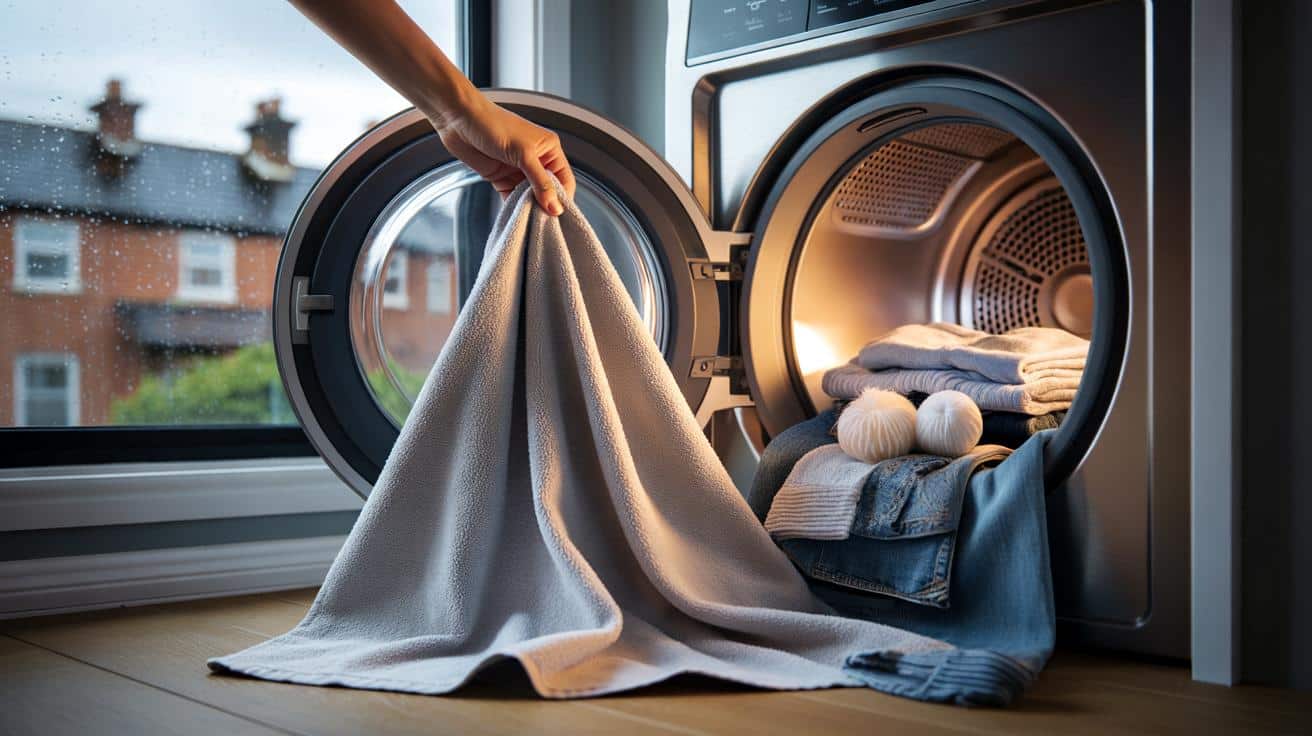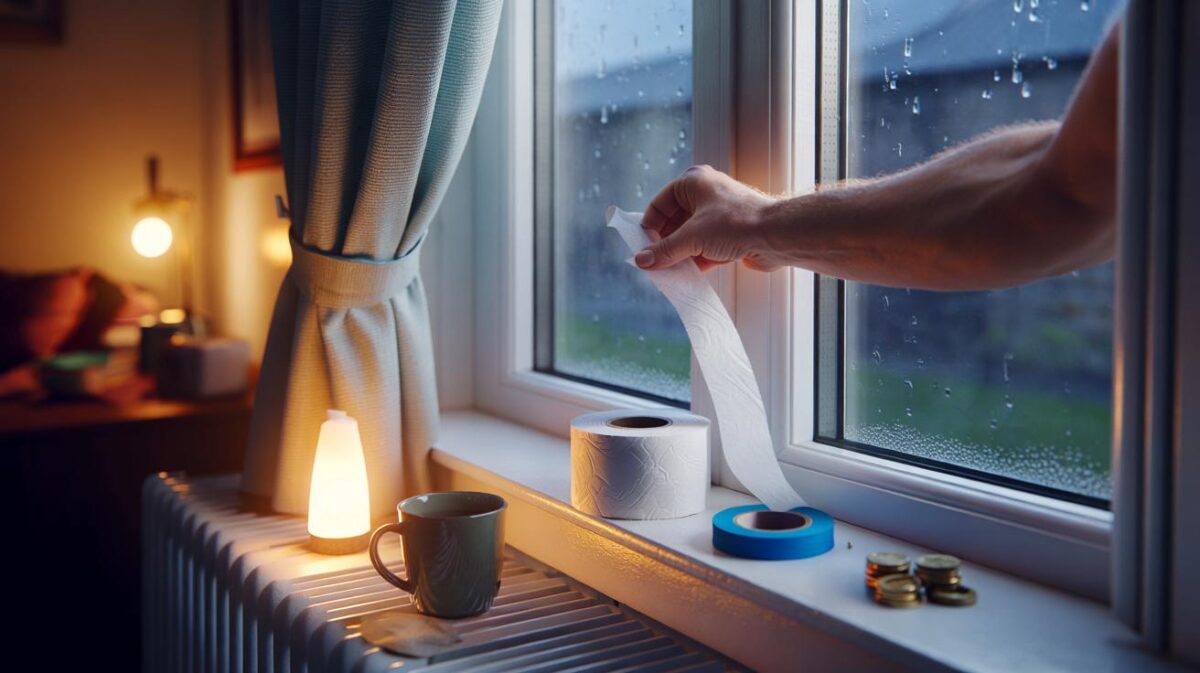Energy bills creeping up, clothes still damp at bedtime, and a dryer that sounds like a jet on the tarmac — the winter laundry spiral is real. We’ve all had that moment when you open the drum, feel the cuffs, and sigh because it needs “another 20 minutes”. A tiny tweak can break the loop.
Socks clung to the door, the school uniforms were on a deadline, and the rain outside said no to the washing line. A friend texted a rogue idea: throw a dry towel into the drum for the first 10 minutes, then take it out and carry on. I laughed, then tried it. The hum changed, the drum sounded lighter, and I checked the clock with a small, suspicious grin. The timer ticked down faster. The air smelled cleaner. A simple domestic hack suddenly felt like wizardry. A towel, of all things.
The science hiding in your laundry basket
A single dry towel can behave like a thirsty companion for your damp clothes. It rides the same heat, soaks up free moisture quickly, and helps break up the clumps that make air flow badly. As the towel takes the first hit of humidity, hot air can do its job on the rest of the load instead of fighting a foggy microclimate. That early acceleration matters because the first stretch of any cycle is where the dryer works hardest.
In a small London terrace, a family of four tried it on a mid-week cotton load: first 10 minutes with one clean bath towel, then remove and resume. The cycle wrapped 12–18 minutes sooner across three runs, and the shirts felt less baked. At the current price cap, a typical tumble-dryer uses anywhere from about 1.5 to 4 kWh per cycle, depending on model and programme. Cutting even 15 minutes from a 60-minute run can trim a chunk of that, which you’ll feel across a busy month.
Why it works is plain physics dressed as housekeeping. The towel is a temporary moisture sink, reducing the vapour load that keeps your drum steamy and stubborn. At the same time, it fluffs the pile, opening up pathways for hot air to sweep through fibres. Sensors tend to behave better, too: when the towel leaves at minute ten, the machine reassesses a lighter, freer-spinning mix and doesn’t overrun as much. Less heat stress on elastics, fewer crispy collars, more life left in your clothes.
The 10-minute towel method, step by step
Load your dryer as usual, but keep it to a sensible, half-to-two-thirds drum for best airflow. Add one large, clean, dry bath towel on top, choose your normal programme, and start a countdown for 10 minutes. When the timer pings, pause the machine, pull the towel out — it will feel damp and warm — and hang it to finish air-drying. Restart the cycle and let the dryer’s sensor or timer do the rest. It takes 10 minutes, not 10 gadgets. If your machine has a “cupboard dry” sensor, you’ll often see it hit the target sooner once the towel’s gone.
Pick a towel with good absorbency and low lint, like a sturdy cotton bath towel or a microfiber bath sheet. Don’t toss in three towels thinking more is better; one is plenty, or two for a bulky bedding load. Clean the lint filter before you start, and check the condenser or heat-pump filter weekly. Mix like with like: heavy jeans with towels, not with delicate blouses. Let’s be honest: no one really does that every day. Even so, matching weights for this one trick pays off right away.
You’ll get the best results if your washer’s final spin is set high — it wrings out the baseline water before the dryer even starts. For heat-pump dryers, the trick still works, just keep the load moderate and the towel single. For condenser and vented machines, expect a punchier early phase and a smoother finish with fewer hot spots. If you’re nervous about colours, use a light neutrally dyed towel the first time and skip brand-new textiles.
“Add a dry, clean bath towel for the first 10 minutes, then remove it and continue — you’re front-loading the evaporation and giving the sensor better data,” says appliance technician Karen Lowe, who sees the same mistake every winter: overloaded drums that never quite dry.
- Use one absorbent towel for 10 minutes, then remove it.
- Keep loads to half–two-thirds full for airflow.
- Clean the lint filter each run; clear heat-pump filters weekly.
- Group fabrics by weight; avoid mixing silks with denim.
- Try wool dryer balls alongside the towel for extra lift.
What this tiny ritual changes — bills, fabric care, daily rhythm
The first time you pull out that damp towel and feel the rest of the clothes drying evenly, you start to see the maths. Minutes saved here ripple into less wear on elastics and prints, fewer re-runs, and a smaller bite from the meter. Some readers report shaving a third off drying time with light loads, closer to half with towels and jeans, and a steady 10–20% with mixed cottons. The common thread is simple: the early phase stops being a slog. The ritual takes almost nothing from your day and gives back predictable results when the weather refuses to cooperate.
| Point clé | Détail | Intérêt pour le lecteur |
|---|---|---|
| 10-minute towel boost | Add one dry towel for the first 10 minutes, then remove | Faster drying, lower energy per load, gentler on fibres |
| Right-size loads | Half to two-thirds full, grouped by fabric weight | Stronger airflow, fewer damp corners, no re-runs |
| Maintenance habits | Clean lint and heat-exchanger filters; high final spin | Keeps performance high and bills down across the season |
FAQ :
- Does the towel trick work with heat-pump dryers?Yes. The gentler heat still benefits from early moisture capture and better airflow. Keep loads moderate and use just one towel.
- What kind of towel is best?A clean, absorbent bath towel in cotton or microfiber. Avoid brand-new, highly pigmented towels on the first try to prevent colour transfer.
- Will this damage clothes or the machine?No. You’re reducing overall heat exposure and mechanical time. Check and clean filters regularly, as usual.
- How much time can I realistically save?On mid-size cotton loads, 10–20 minutes is common; with heavy textiles it can be more. Results vary by model and room humidity.
- Can I leave the towel in for the whole cycle?You can, though it’s less effective. The magic is front-loaded. Remove it after 10 minutes so the rest of the load dries freely.









